Article and all photos by Joe Mock, BaseballParks.com
All rights reserved
 |
An interesting equilibrium of sorts has occurred in the realm of spring training. I don’t know if you’ve noticed, but there are now 15 MLB teams that train in Florida, and 15 in Arizona. Aside from the fact that this means there are all kinds of split-squad exhibition games happening because there are an odd number of teams in each state, it also makes comparisons more interesting.
| Ballpark Stats |
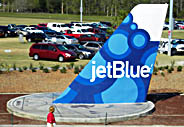 |
| Team: Spring Training home of the Red Sox |
| First MLB game: March 4, 2012, an 8-3 Red Sox win over the Twins |
| Capacity: 11,000, of which 9,900 are fixed seats |
| Architect: Populous along with local architect Parker/Mudgett/Smith |
| Construction: Manhattan |
| Price: $77.8 million |
| Home dugout: 3B side |
| Field points: East by northeast |
| Playing surface: Celebration Bermuda grass |
| Betcha didn’t know: While the field dimensions are the same as at Fenway, the Green Monster here is six feet taller than the one in Boston |
For instance, just as spring training in Florida is quite different than in Arizona due to weather (lots of pop-up storms in Florida and enormously higher humidity) and geography (you can drive for hours to get from one camp in Florida to another), there is also a difference in the way the complexes themselves are laid out. In Florida, 13 of the 14 camps host just one team, with only Jupiter including two occupants (Marlins and Cards). In Arizona, every new complex built in the last decade was super-sized, making them big enough for two teams. Those dual-team complexes are in Surprise, Goodyear, Glendale and Salt River, while the older complex in Peoria also hosts two teams.
These Arizona complexes are not only larger, they tend to be more elaborate and much more costly to build.
Enter Fenway South, the new complex for the Boston Red Sox on the outskirts of Fort Myers. The facilities and central ballpark immediately put it at the top of the heap in Florida, and give many of the newer facilities in the Grand Canyon State a run for their money. And at the heart of the complex is JetBlue Park, the incredible stadium where the field plays very much like at Fenway, but spacious, modern conveniences make it a hassle-free joy to attend a game.
“What we were trying to achieve was the intimacy of Fenway with a Florida kind of feel,” said Zach Allee, Senior Architect at Populous, the sports-architecture heavyweights who designed the complex. I would contend that what they actually achieved was much, much more.
But how did spring training for the Red Sox end up in this vacant pasture near the Southwest Florida Airport? Well, New Englanders have been flocking to Lee County in Florida to watch their favorite Sox players work out since 1993, when the team moved its spring operations from Winter Haven, ending a 27-year run in Central Florida. In fact, City of Palms Park near the central part of Fort Myers was constructed for them in 1993. The only problem was that the practice fields where the players worked out all morning, and where the springtime scrimmages were played in the afternoons, were about two miles away from the ballpark. While not insurmountable, this was certainly not an optimal arrangement.
Also, City of Palms Park with its massive roof (handy for shade and the inevitable spring showers) was no longer adequate for a team with as high a profile as the Red Sox. When the team started making noises about opting out of its lease with the city of Fort Myers, a number of cities started jockeying for position. In particular, the city of Sarasota made a very strong push, at first offering to build a brand-new complex and stadium for the team. When voters turned that down, the city countered with a significantly renovated Ed Smith Stadium, because the Reds had notified Sarasota that they would be vacating the facility to move to Goodyear, AZ following the spring of 2009.
| What the Sox left behind |
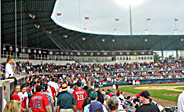 |
| City Of Palms Park hosted Red Sox exhibition games starting in 1993. It isn’t a terrible facility by any means, but it didn’t have enough luxury suites or adequate merchandise space … and perhaps worst of all, the practice fields weren’t at the same location. |
The Red Sox weren’t interested in another team’s hand-me-down facilities, so they said no thanks to Sarasota. As an aside, after seeing what a spectacular $31 million renovation did for Ed Smith Stadium, I’m not so sure the Sox should’ve looked down their noses at it. Regardless, the Orioles are quite content in Sarasota now.
Meanwhile, Lee County had gotten very serious about keeping the Bosox. They knew that having Red Sox Nation descend on southwest Florida had an economic impact of approximately $25 million each spring.
Following a lengthy study, five possible sites for a new complex were proposed. I visited all of the sites when I was in the area for spring training in 2009, and I felt that the one on Daniels Parkway near the airport was easily the best choice. Indeed, that was the site selected in 2010, and the design and construction work began in earnest.
The land didn’t come cheap, by the way, accounting for $20 million of the $77.8 million price tag for the project. The funding for the complex came from a public-private partnership, where much of the public outlay came from a “bed tax” on hotel rooms in the area.
But how did the finished product turn out? Are those passionate Red Sox fans happy with their new springtime playground? Read on as we look at JetBlue Park at Fenway South from four perspectives: its location; its exterior; its interior design and amenities for the fans.
The Setting
The 106-acre site selected by Lee County and agreed upon by the Red Sox is on the east side of Interstate 75. If you’re familiar with the area, you know that the vast majority of development in Fort Myers has occurred west of I-75, which is the side that has the beaches on the Gulf of Mexico.
The fact that there had been little development done near the chosen site isn’t a bad thing. In fact, it probably opens the possibility of the Red Sox doing some real-estate development in the future.
I assume that this exact site was chosen from the five finalists due to several factors. First, a four-lane highway (Daniels Parkway, also known as County Highway 876) already existed adjacent to the site, and better yet, Daniels already had an interchange with I-75 only a mile away. Second, a major airport is less than a mile away, and Southwest Florida International Airport is serviced by airlines such as Southwest, Delta, United, US Air, Air Tran and, most importantly, JetBlue, which offers non-stops from Boston. Third, the site itself was essentially a pasture and not a forest, so preparing the site for construction was easier. And fourth, the potential for development was strong.
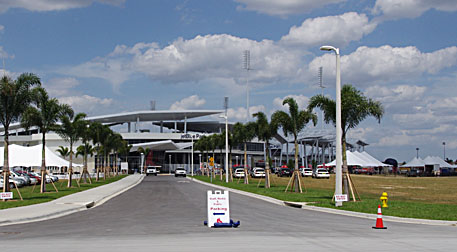 |
On this last point, the area along Daniels Parkway wasn’t nearly “built up.” Unlike Daniels Parkway west of I-75, the area to the east had very few commercial endeavors or housing projects. There’s little doubt that this area will attract neighborhoods and condos, as other spots east of I-75 in Fort Myers and nearby Estero have. In other words, the Red Sox have the opportunity to implement commercial development when the time is right. In fact, according to Sue Denny, the Customer Service Manager for the Red Sox’ spring operations, 20 acres between the complex and Daniels Parkway have been set aside for future development. In the meantime, they are being used for parking (see the right-hand portion of the photo above).
The Exterior
The ballpark at the heart of the Fenway South complex isn’t in the center of the complex. Unlike complexes where two Major League teams train, there was no need for JetBlue Park to be at the geographic center of the site. Only one team’s needs were taken into account, and I have to imagine that the Red Sox are extremely pleased with the way their needs were met.
In a way, there are two clubhouses here. The Major League quarters are on the east end of the building that is connected to the park, while the Minor Leaguers use the west end. Just to the north of the clubhouses is a huge array of covered batting cages (see the left-hand photo below. The building in the center holds the batting cages), and just to the north of those are the practice fields. You get a great view of this layout from the top of the Green Monster (below right).
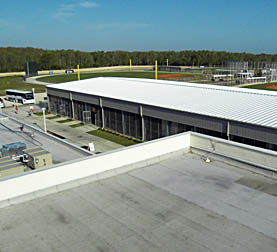  |
One difference between the newer complexes in Arizona and ones like Fenway South in Florida is the “aesthetics.” At Camelback Ranch and Salt River Fields in Arizona, literally millions of dollars were spent on landscaping and gorgeous walkways through the practice fields. Not so here, but perhaps this is partially due to the fact that only one team trains here, not two like at Camelback Ranch and Salt River Fields.
JetBlue Park itself, though, is quite elaborate. As you’re driving or walking up to it, you’ll certainly be struck by its distinctive, modern look.
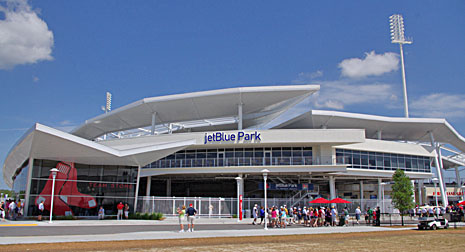 |
Concrete, block, glass, uneven roof … the exterior is nothing like Fenway. But that’s OK, because it works beautifully, plus it feels right at home in Florida.
On the far left of the shot above, you’ll see two huge, red “sox” on the glass. This is the exterior of the souvenir shop, and we’ll have much more to say about it later. And if you look closely, you’ll see that the cluster of people in the middle of the photo isn’t in line to enter the main part of the ballpark. No, they are going through turnstiles to enter an area that is actually outside the main footprint of the structure.
And this area is both wonderful and exactly like Fenway. If you’ve attended a Red Sox home game in Boston, you’ve no doubt noticed that Yawkey Way in front of the park is closed on gamedays. In fact, to get into this closed-off street, you have to have a ticket to the game. Once inside the fencing and barricades, you’ll find countless vendors, most of whom are selling food items.
That’s how it works at JetBlue Park, too. The street that runs right next to the park on the first-base side is called Fenway South Drive, and starting about an hour before the gates open, it is fenced off and every manner of vendor sets up shop. We’ll talk more about the food there in “The Essentials” portion of this review, but for now, you can see in the photos below that it is set up somewhat like a street fair, with both free-standing kiosks and large tents. I really love both the concept and the food there.
 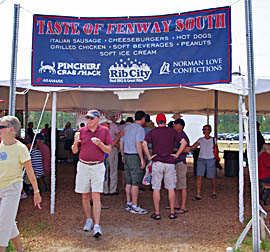 |
There are several other entryways you can use to get inside the ballpark, but none have the festive atmosphere of Fenway South Drive. Whatever you do, though, I highly suggest you visit the plaza behind home plate and another one behind third base before you enter go through the turnstiles.
The one behind home features a sight that is quite familiar to Red Sox fans, whether they’ve attended Sox exhibitions in Fort Myers previously or regular-season games in Boston. Here is a larger-than-life-size bronze statue of the Splendid Splinter himself, Ted Williams (below left). This 2,750-pound statue, which used to sit just outside the entry gates at City of Palms Park, is a replica of one that is at Fenway. Here in Fort Myers, the statue is surrounded by nine palm trees, because Williams’ uniform number was 9.
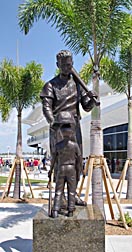 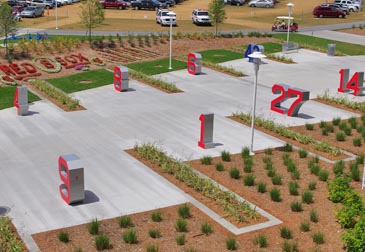 |
Speaking of uniform numbers, to your left as you’re looking at the statue is the Hall Of Fame Plaza (shown above right), where the retired numbers of the Red Sox — plus one — are featured. “We viewed this area as the gateway to spring training for the fans, because it leads to the practice fields,” said Populous’ Allee. The intent, he added, was for the walk through the fenced-off street, the statue, the retired numbers and a huge JetBlue sundial (below left) to “enhance the fans’ experience, even when there’s not a game. Eventually, there will be a walkway that circles the entire complex.” Allee referred to this as “the Fenwalk.”
The retired numbers, by the way, are #1 for Bobby Doerr, #4 for Joe Cronin, #6 for Johnny Pesky, #8 for Carl Yastrzemski, #9 for Williams, #14 for Jim Rice and #27 for Carlton Fisk. You’ll also find #42 here, as all MLB teams have retired Jackie Robinson’s number.
 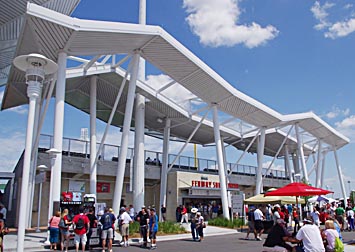 |
You can’t talk about the look of the ballpark’s exterior without mentioning the wild roof over top of it. In fact, when I asked Allee to name his favorite aspect of the park, he quickly answered, “The canopy, because it’s such an iconic piece.” I agreed, but I had to ask why in the world it is uneven. “The undulating roof was inspired by the cypress trees (canopies and branches) that surround the site,” he explained. That roof is most definitely distinctive.
The building material itself is quite interesting. In addition to the steel and concrete that you see, there is also an aggregate type of block that is used. “From a distance, it looks like stone,” Allee pointed out. “But when you look at it up close, you see that it’s made up of coral and tiny shells.” Make a point of examining this when you visit JetBlue Park. It’s just one of the many interesting aspects of its exterior.
Now let’s take a look inside the ballpark.